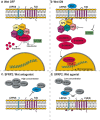Secreted frizzled-related protein 2: a key player in noncanonical Wnt signaling and tumor angiogenesis
- PMID: 33140138
- PMCID: PMC7897195
- DOI: 10.1007/s10555-020-09941-3
Secreted frizzled-related protein 2: a key player in noncanonical Wnt signaling and tumor angiogenesis
Abstract
Secreted frizzled-related proteins (SFRP) are glycoproteins containing a so-called frizzled-like cysteine-rich domain. This domain enables them to bind to Wnt ligands or frizzled (FzD) receptors, making potent regulators of Wnt signaling. As Wnt signaling is often altered in cancer, it is not surprising that Wnt regulators such as SFRP proteins are often differentially expressed in the tumor microenvironment, both in a metastatic and non-metastatic setting. Indeed, SFRP2 is shown to be specifically upregulated in the tumor vasculature of several types of cancer. Several studies investigated the functional role of SFRP2 in the tumor vasculature, showing that SFRP2 binds to FzD receptors on the surface of tumor endothelial cells. This activates downstream Wnt signaling and which is, thereby, stimulating angiogenesis. Interestingly, not the well-known canonical Wnt signaling pathway, but the noncanonical Wnt/Ca2+ pathway seems to be a key player in this event. In tumor models, the pro-angiogenic effect of SFRP2 could be counteracted by antibodies targeting SFRP2, without the occurrence of toxicity. Since tumor angiogenesis is an important process in tumorigenesis and metastasis formation, specific tumor endothelial markers such as SFRP2 show great promise as targets for anti-cancer therapies. This review discusses the role of SFRP2 in noncanonical Wnt signaling and tumor angiogenesis, and highlights its potential as anti-angiogenic therapeutic target in cancer.
Keywords: Angiogenesis; Cancer; SFRP2; Therapeutic target; Tumor vasculature; Wnt signaling.
Conflict of interest statement
The author states that they have no conflict of interest.
Figures




Similar articles
-
Frizzled-5: a high affinity receptor for secreted frizzled-related protein-2 activation of nuclear factor of activated T-cells c3 signaling to promote angiogenesis.Angiogenesis. 2017 Nov;20(4):615-628. doi: 10.1007/s10456-017-9574-5. Epub 2017 Aug 24. Angiogenesis. 2017. PMID: 28840375 Free PMC article.
-
Secreted Frizzled-related Protein 2 (sFRP2) Redirects Non-canonical Wnt Signaling from Fz7 to Ror2 during Vertebrate Gastrulation.J Biol Chem. 2016 Jun 24;291(26):13730-42. doi: 10.1074/jbc.M116.733766. Epub 2016 Apr 29. J Biol Chem. 2016. PMID: 27129770 Free PMC article.
-
Secreted Frizzled Related Protein 2 Modulates Epithelial-Mesenchymal Transition and Stemness via Wnt/β-Catenin Signaling in Choriocarcinoma.Cell Physiol Biochem. 2018;50(5):1815-1831. doi: 10.1159/000494862. Epub 2018 Nov 5. Cell Physiol Biochem. 2018. PMID: 30396168
-
Secreted frizzled-related protein 2-mediated cancer events: Friend or foe?Pharmacol Rep. 2017 Jun;69(3):403-408. doi: 10.1016/j.pharep.2017.01.001. Epub 2017 Jan 9. Pharmacol Rep. 2017. PMID: 28273499 Review.
-
Wnt/frizzled Signaling in Endothelium: A Major Player in Blood-Retinal- and Blood-Brain-Barrier Integrity.Cold Spring Harb Perspect Med. 2022 May 17;12(4):a041219. doi: 10.1101/cshperspect.a041219. Cold Spring Harb Perspect Med. 2022. PMID: 35074794 Free PMC article. Review.
Cited by
-
Characterization of Wnt signaling pathway under treatment of Lactobacillus acidophilus postbiotic in colorectal cancer using an integrated in silico and in vitro analysis.Sci Rep. 2023 Dec 27;13(1):22988. doi: 10.1038/s41598-023-50047-x. Sci Rep. 2023. PMID: 38151510 Free PMC article.
-
Multiomics Analysis Reveals Cuproptosis-Related Signature for Evaluating Prognosis and Immunotherapy Efficacy in Colorectal Cancer.Cancers (Basel). 2023 Jan 6;15(2):387. doi: 10.3390/cancers15020387. Cancers (Basel). 2023. PMID: 36672336 Free PMC article.
-
SFRP2 Overexpression Induces an Osteoblast-like Phenotype in Prostate Cancer Cells.Cells. 2022 Dec 16;11(24):4081. doi: 10.3390/cells11244081. Cells. 2022. PMID: 36552843 Free PMC article.
-
Single-nucleus multiomics reveals the gene-regulatory networks underlying sex determination of murine primordial germ cells.bioRxiv [Preprint]. 2024 Sep 25:2024.02.19.581036. doi: 10.1101/2024.02.19.581036. bioRxiv. 2024. Update in: Elife. 2025 Mar 10;13:RP96591. doi: 10.7554/eLife.96591. PMID: 39386556 Free PMC article. Updated. Preprint.
-
Exploring the origin of the cancer stem cell niche and its role in anti-angiogenic treatment for glioblastoma.Front Oncol. 2022 Aug 25;12:947634. doi: 10.3389/fonc.2022.947634. eCollection 2022. Front Oncol. 2022. PMID: 36091174 Free PMC article. Review.
References
-
- Finch PW, He X, Kelley MJ, Uren A, Schaudies RP, Popescu NC, Rudikoff S, Aaronson SA, Varmus HE, Rubin JS. Purification and molecular cloning of a secreted, frizzled-related antagonist of Wnt action. Proceedings of the National Academy of Sciences of the United States of America. 1997;94(13):6770–6775. doi: 10.1073/pnas.94.13.6770. - DOI - PMC - PubMed
-
- Bhati R, Patterson C, Livasy CA, Fan C, Ketelsen D, Hu Z, Reynolds E, Tanner C, Moore DT, Gabrielli F, Perou CM, Klauber-DeMore N. Molecular characterization of human breast tumor vascular cells. The American Journal of Pathology. 2008;172(5):1381–1390. doi: 10.2353/ajpath.2008.070988. - DOI - PMC - PubMed
Publication types
MeSH terms
Substances
LinkOut - more resources
Full Text Sources
Medical
Research Materials

